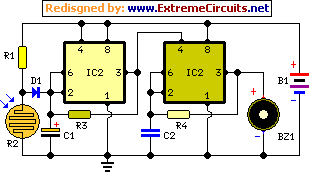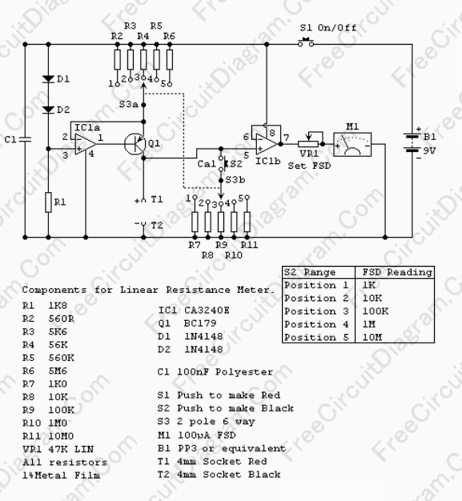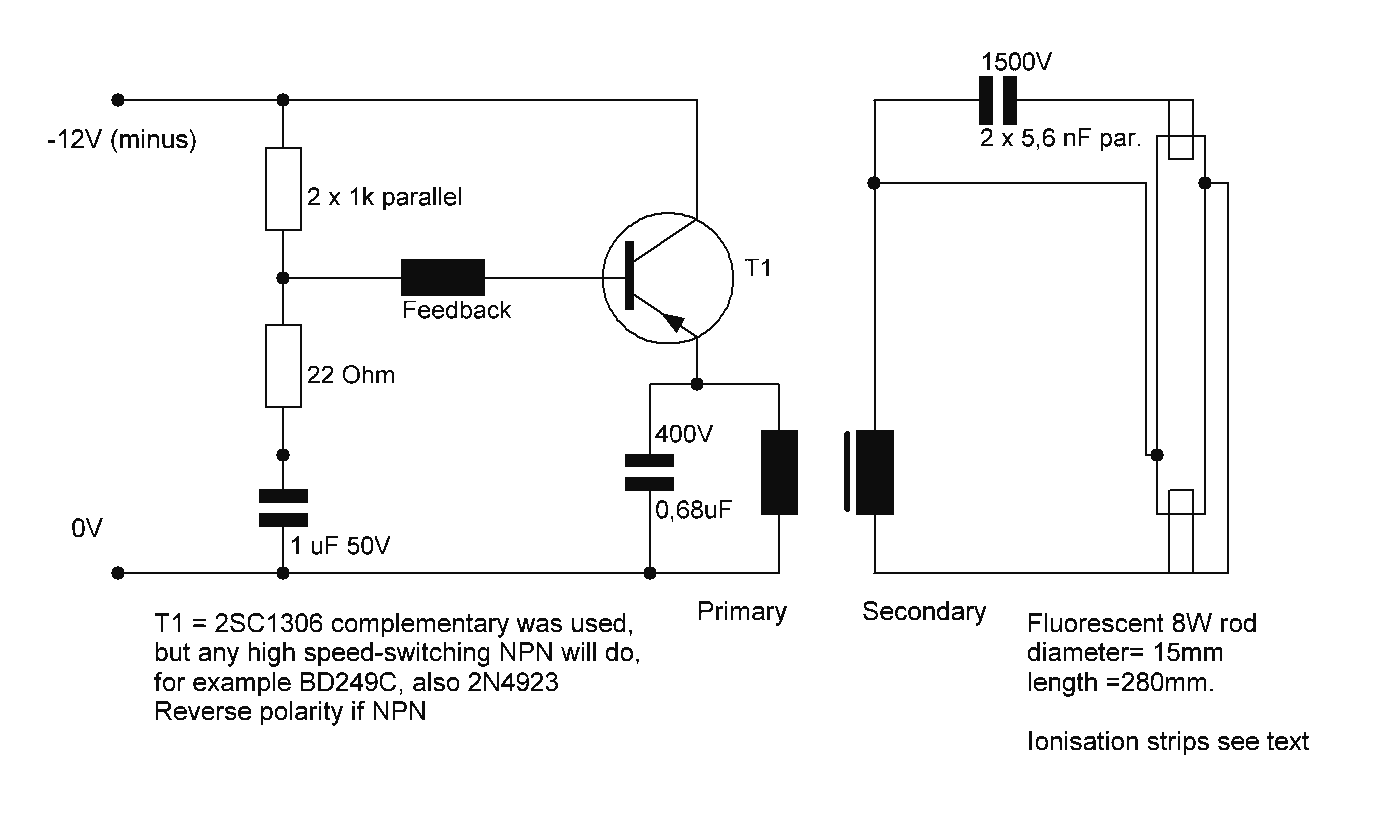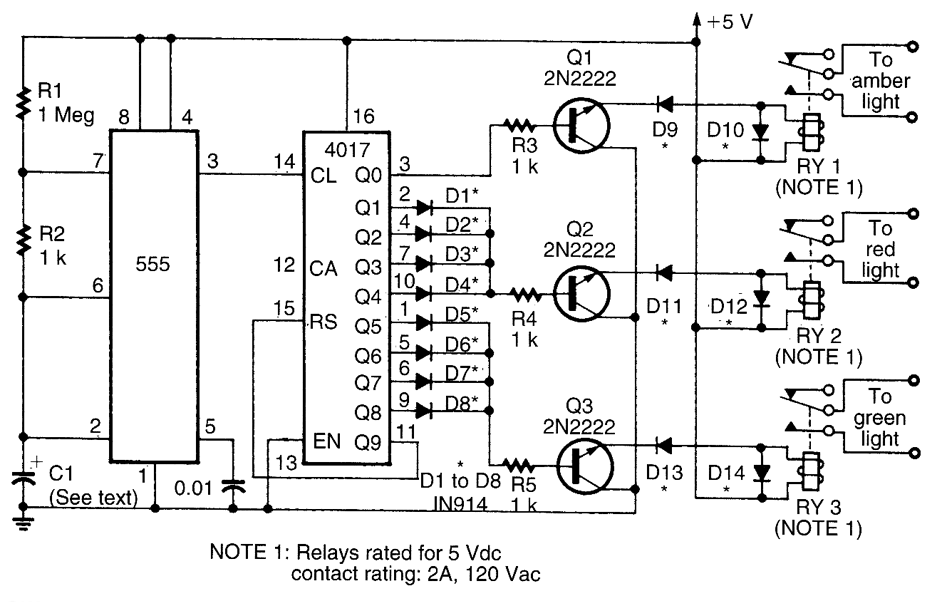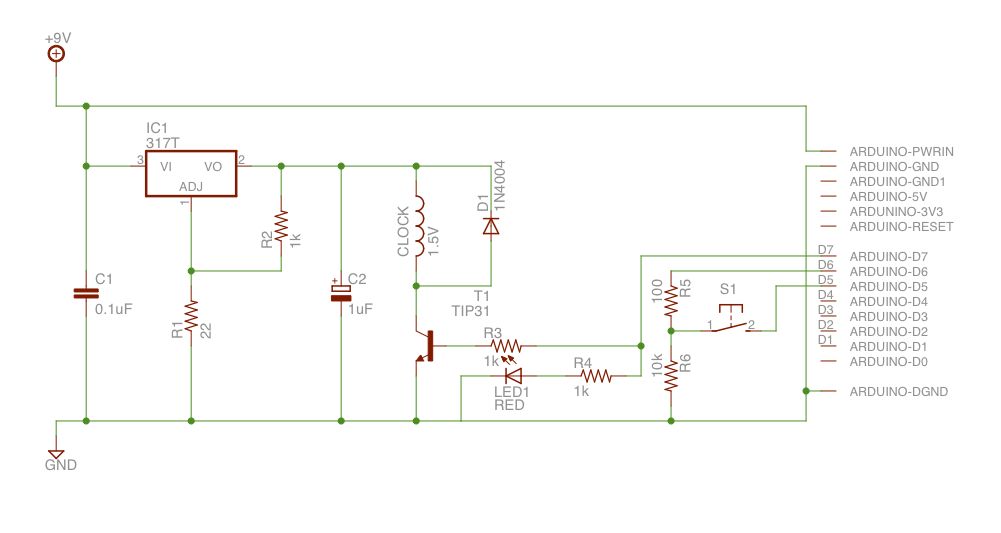
Hydro alarm circuit diagram using CMOS
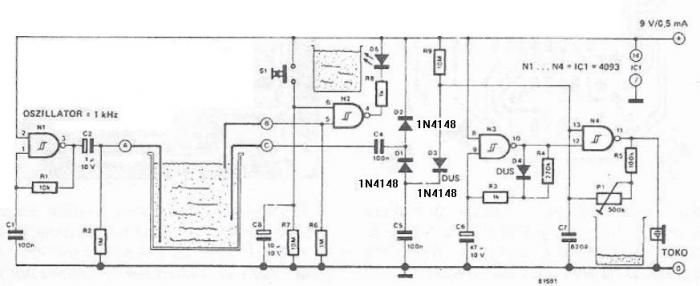
The circuit diagram is straightforward and operates as follows: the N1 Schmitt trigger functions as an oscillator, producing a frequency of approximately 1 kHz. When there is sufficient water in the tank, alternating voltage flows from electrode A to electrode C. After being rectified by diodes D1 and D2, a logical "0" reaches pin 13 of N4 through D3. Consequently, the oscillator sound from N4 and the buzzer are disconnected. If the water level drops to the point where electrode C is no longer submerged, the blocking of N4 is lifted, and the buzzer begins to sound at regular intervals. The duration of the alarm is determined by the oscillator capacitor N3 and capacitor C6. The alarm ceases once the tank is filled and electrode C comes back into contact with the water. If the S1 button is activated before filling, LED D5 lights up as soon as the water reaches electrode B. D5 turns off after approximately 10 seconds to prevent excessive power consumption. The supply voltage can range from 5 to 15 V. If a voltage lower than 9 V is selected, the surface area of electrode C must be significantly larger than that of electrode B. This is necessary due to signal loss from electrode C through diodes D1 and D3.
The circuit utilizes a Schmitt trigger (N1) to create a stable oscillation at around 1 kHz, which is essential for the operation of the water level monitoring system. The N1 Schmitt trigger ensures that the output is not affected by noise, providing a reliable oscillation that drives the subsequent components. The alternating voltage generated by the oscillator is directed from electrode A to electrode C, where it is rectified by diodes D1 and D2. This rectification is crucial as it converts the AC signal into a DC signal that can be interpreted by the logic gate at pin 13 of N4.
When the water level is adequate, the output at pin 13 remains low, preventing the buzzer from sounding. However, once the water level falls below the threshold, electrode C loses contact with water, causing N4 to become unblocked. This transition activates the buzzer, which emits sound at regular intervals, alerting users to the low water level. The timing of the alarm is controlled by the combination of oscillator capacitor N3 and capacitor C6, which dictate how long the buzzer remains active.
Moreover, the circuit includes a manual override feature via the S1 button. When pressed, this button temporarily activates LED D5, providing a visual indication that the water has reached electrode B. This LED is designed to turn off after approximately 10 seconds, which helps manage power consumption effectively.
The circuit is designed to operate within a supply voltage range of 5 to 15 V. It is important to consider that if the voltage is set below 9 V, the surface area of electrode C must be larger than that of electrode B to ensure proper operation. This requirement arises from the inherent signal loss that occurs through diodes D1 and D3, which can affect the performance of the monitoring system.
In summary, this water level monitoring circuit is an efficient and effective solution for detecting low water levels in a tank, utilizing a combination of oscillators, rectifiers, and logic gates to provide both audible and visual alerts. The design ensures reliability and power efficiency, making it suitable for various applications.Circuit diagram is very simple and works as follows: N1 Schmitt trigger works as an oscillator and produce a frequency of about 1 kHz. If in the tank is still enough water, then alternative voltage go from electrode A to electrode C. After rectified of diodes D1 and D2, at the pin 13 of the N4 reaches trough the D3 a logical "0". By this, the osci llator sound N4 and buzzer are disconnected. If the water level drops into such an extent that electrode C is no longer in contact with water, then blocking of N4 is suspended and buzzer starts to sound at regular intervals. Alarm duration is determined by the oscillator capacitor N3 and C6. The alarm stops as soon as the tank fills and electrode C is again in contact with water. If S1 button operates before filling D5 LED lights as soon as water reaches the electrode B. D5 turns off after about 10 seconds to load is not too much power. Supply voltage can be between 5 and 15 V. If you choose a voltage lower than 9 V, the electrode surface C must be much higher than that of electrode B.
This necessary because there is loss of signal from the electrode C in diodes D1. D3. 🔗 External reference
The circuit utilizes a Schmitt trigger (N1) to create a stable oscillation at around 1 kHz, which is essential for the operation of the water level monitoring system. The N1 Schmitt trigger ensures that the output is not affected by noise, providing a reliable oscillation that drives the subsequent components. The alternating voltage generated by the oscillator is directed from electrode A to electrode C, where it is rectified by diodes D1 and D2. This rectification is crucial as it converts the AC signal into a DC signal that can be interpreted by the logic gate at pin 13 of N4.
When the water level is adequate, the output at pin 13 remains low, preventing the buzzer from sounding. However, once the water level falls below the threshold, electrode C loses contact with water, causing N4 to become unblocked. This transition activates the buzzer, which emits sound at regular intervals, alerting users to the low water level. The timing of the alarm is controlled by the combination of oscillator capacitor N3 and capacitor C6, which dictate how long the buzzer remains active.
Moreover, the circuit includes a manual override feature via the S1 button. When pressed, this button temporarily activates LED D5, providing a visual indication that the water has reached electrode B. This LED is designed to turn off after approximately 10 seconds, which helps manage power consumption effectively.
The circuit is designed to operate within a supply voltage range of 5 to 15 V. It is important to consider that if the voltage is set below 9 V, the surface area of electrode C must be larger than that of electrode B to ensure proper operation. This requirement arises from the inherent signal loss that occurs through diodes D1 and D3, which can affect the performance of the monitoring system.
In summary, this water level monitoring circuit is an efficient and effective solution for detecting low water levels in a tank, utilizing a combination of oscillators, rectifiers, and logic gates to provide both audible and visual alerts. The design ensures reliability and power efficiency, making it suitable for various applications.Circuit diagram is very simple and works as follows: N1 Schmitt trigger works as an oscillator and produce a frequency of about 1 kHz. If in the tank is still enough water, then alternative voltage go from electrode A to electrode C. After rectified of diodes D1 and D2, at the pin 13 of the N4 reaches trough the D3 a logical "0". By this, the osci llator sound N4 and buzzer are disconnected. If the water level drops into such an extent that electrode C is no longer in contact with water, then blocking of N4 is suspended and buzzer starts to sound at regular intervals. Alarm duration is determined by the oscillator capacitor N3 and C6. The alarm stops as soon as the tank fills and electrode C is again in contact with water. If S1 button operates before filling D5 LED lights as soon as water reaches the electrode B. D5 turns off after about 10 seconds to load is not too much power. Supply voltage can be between 5 and 15 V. If you choose a voltage lower than 9 V, the electrode surface C must be much higher than that of electrode B.
This necessary because there is loss of signal from the electrode C in diodes D1. D3. 🔗 External reference
